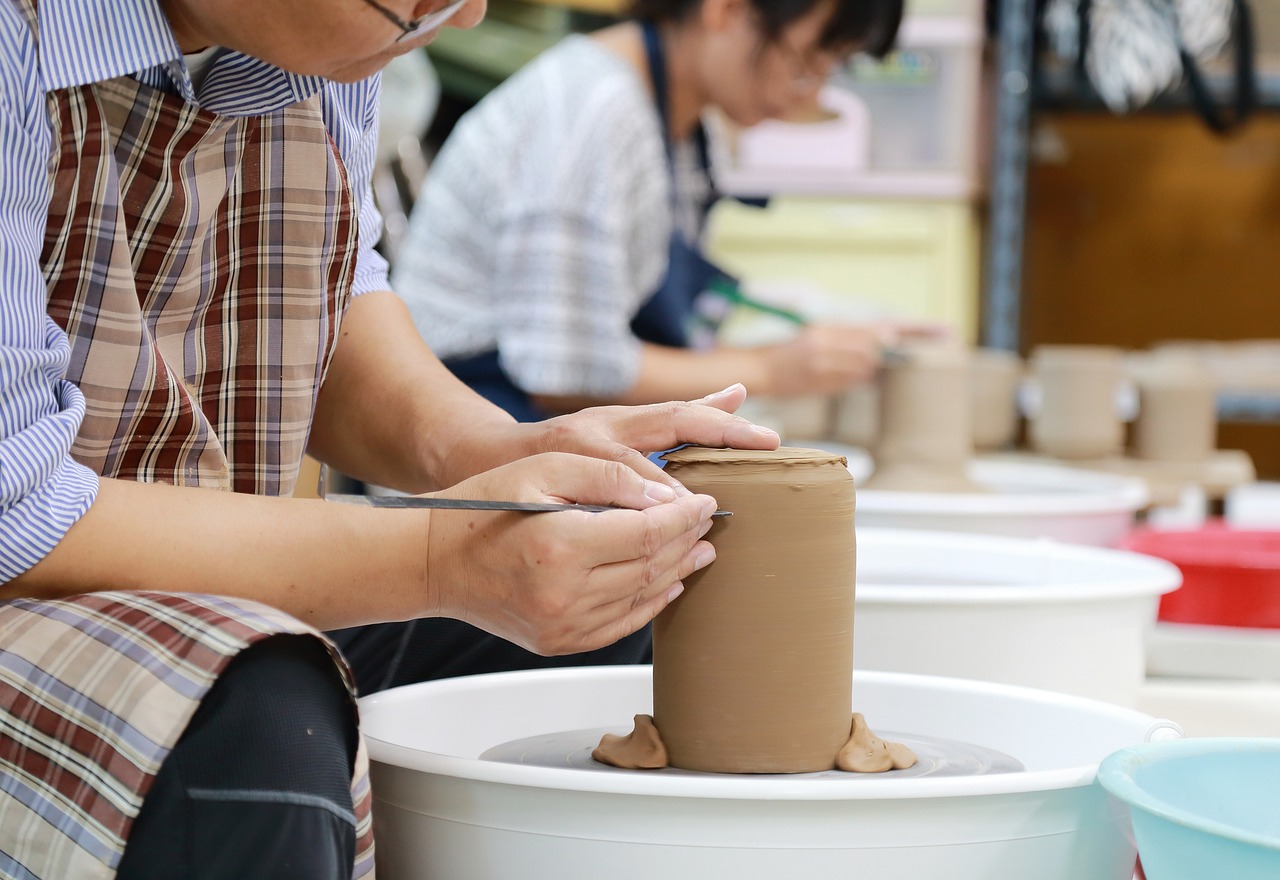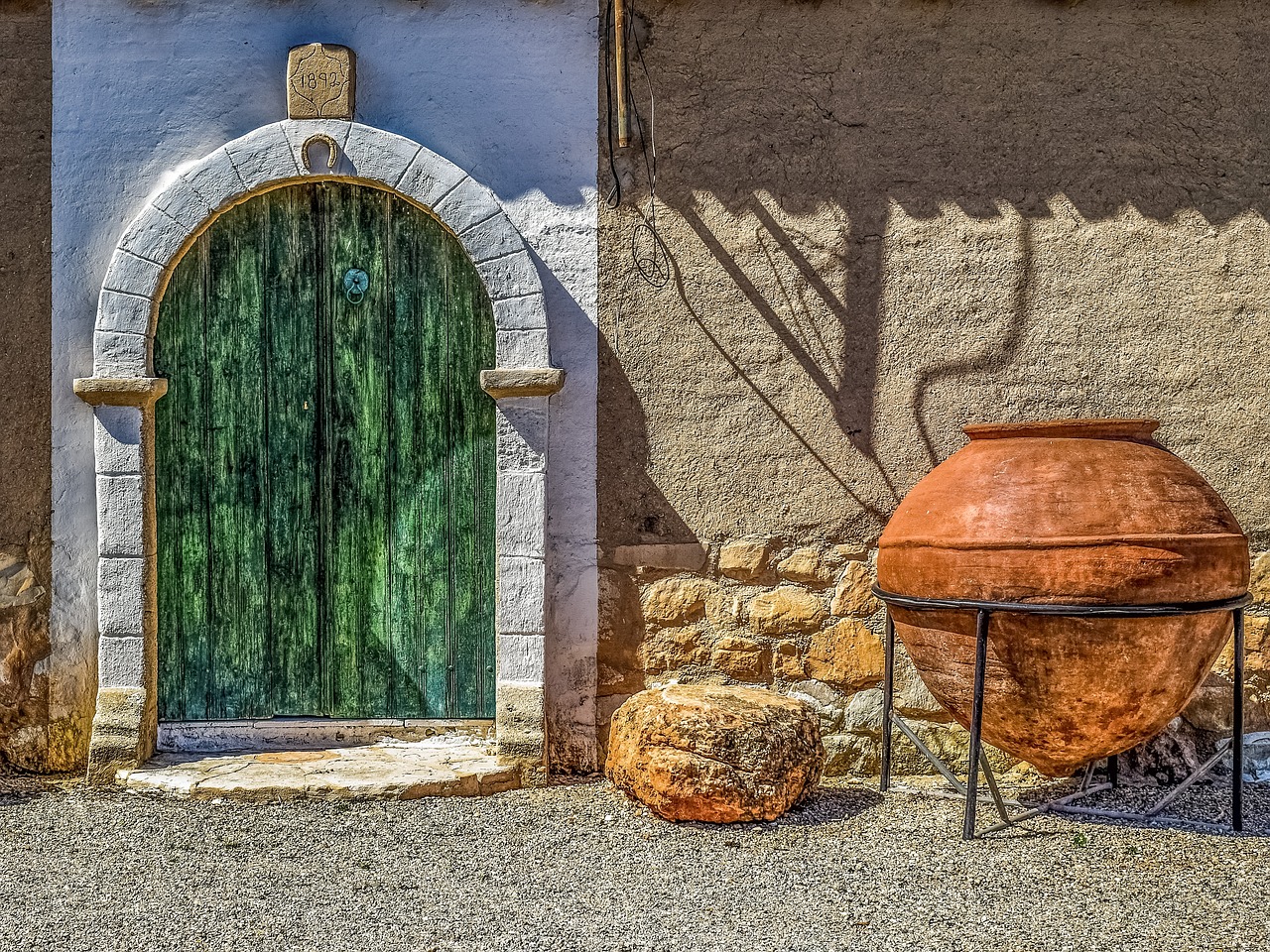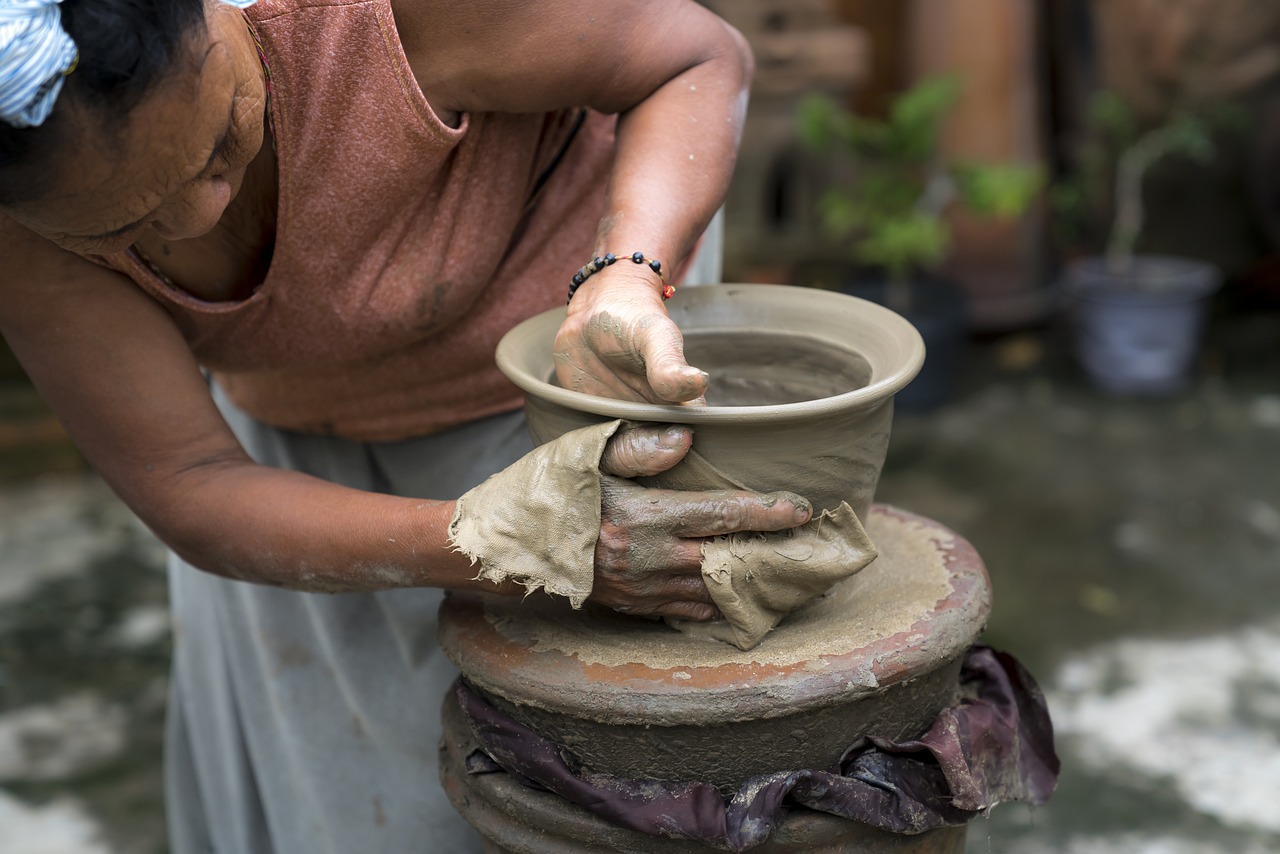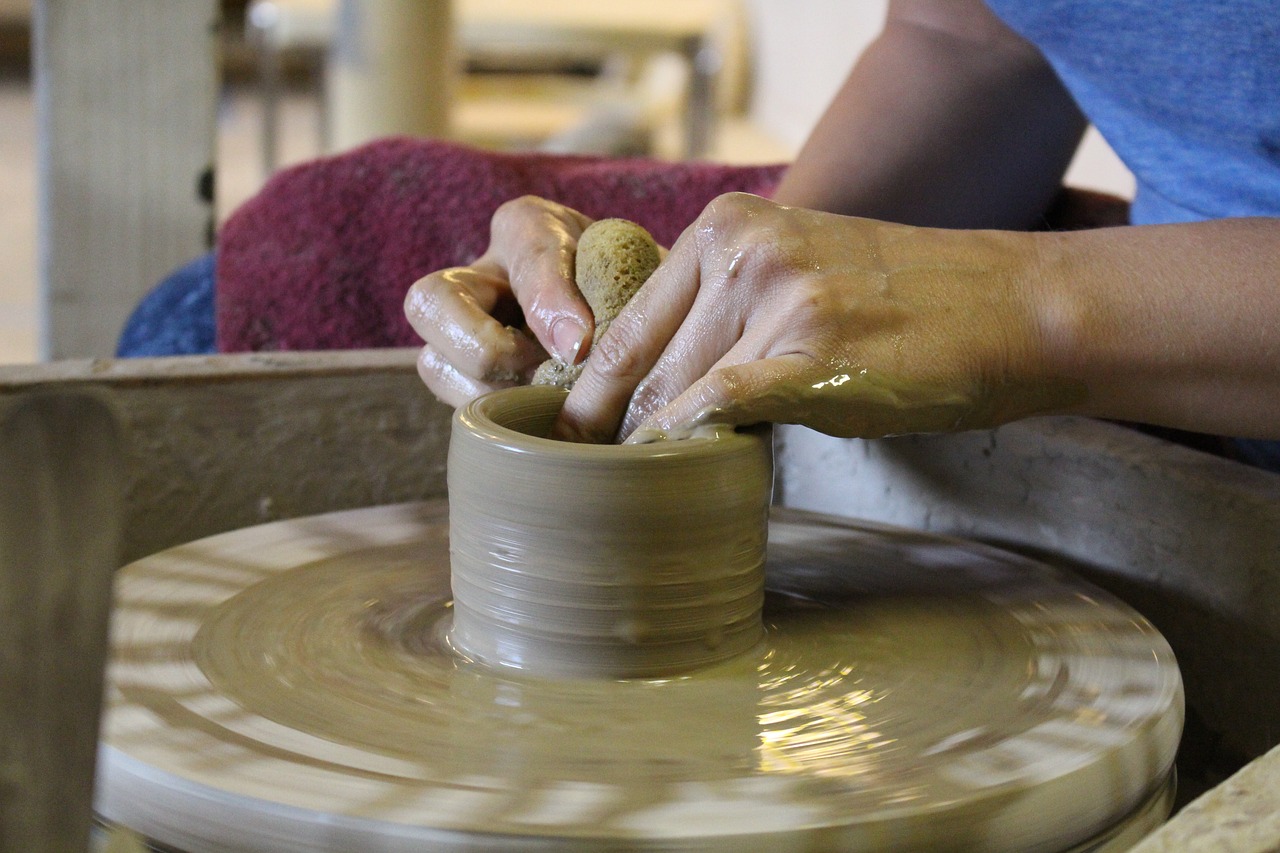Guide: Turning Pottery from Hobby into a Business
Are you passionate about pottery and dreaming of transforming that passion into a thriving business? You're not alone! Many artists find themselves at a crossroads, wondering how to take their creative hobby to the next level. The journey from hobbyist to entrepreneur can be both exciting and daunting, but with the right strategies and mindset, you can make it happen. This guide will walk you through essential steps to establish your pottery business, from identifying your niche to effective marketing strategies, and everything in between.
First things first, let's talk about what makes your pottery unique. In a world saturated with options, carving out a specific niche can be your secret weapon. Think about your personal style and the types of pottery you love creating. Are you drawn to functional pieces like mugs and plates, or do you prefer artistic sculptures? Understanding your unique selling proposition (USP) is crucial. This is what will set you apart from your competitors and attract your ideal customers.
Once you've identified your niche, the next step is to create a business plan. This is more than just a formal document; it's your roadmap to success. A well-structured business plan outlines your goals, strategies, and financial projections. It helps you stay focused and organized. Plus, if you're looking for investors or loans, a solid business plan can be your ticket to securing the funds you need. Your plan should include sections on market research, competitor analysis, and customer demographics, all of which will guide your decision-making process.
Speaking of market research, this is where the fun begins! Understanding your competition and the preferences of your potential customers is key to positioning your pottery business effectively. Dive deep into the pottery market—analyze trends, customer behaviors, and what makes your competitors tick. By evaluating their strengths and weaknesses, you can identify opportunities to differentiate your offerings. For instance, if you notice a gap in the market for eco-friendly pottery, you might consider incorporating sustainable practices into your production.
Another critical aspect of your business plan is setting pricing strategies. Pricing your pottery can feel like walking a tightrope. You want to ensure your prices are competitive but also reflect the value of your craftsmanship. Start by calculating your production costs, including materials, labor, and overhead. Then, look at what similar products are selling for in your niche. Remember, pricing isn't just about numbers; it's about perception. Your price should convey the quality and uniqueness of your pottery.
Now that you have a solid foundation, it’s time to dive into marketing your pottery business. In today’s digital age, effective marketing strategies are essential for increasing visibility and attracting customers. Social media platforms like Instagram and Facebook are fantastic for showcasing your creations. Share behind-the-scenes glimpses of your pottery-making process, engage with your followers, and build a community around your brand. Remember, people love stories—so tell yours!
Building an online presence is equally important. A professional website not only serves as your online portfolio but also allows customers to browse and purchase your pottery with ease. Consider utilizing e-commerce platforms to expand your reach even further. The more accessible your pottery is, the more likely you are to attract buyers.
Lastly, don’t underestimate the power of networking and community engagement. Building relationships within the pottery community can lead to collaborations and increased visibility. Attend workshops, join local art groups, and participate in craft fairs. These events not only provide exposure but also allow for direct interaction with potential customers. Collaborating with other artists can diversify your offerings and attract new audiences, so keep an eye out for partnership opportunities!
- How do I price my pottery?
Start by calculating your production costs and researching competitor pricing. Aim for a balance between competitive pricing and reflecting the value of your craftsmanship. - What platforms should I use to sell my pottery?
Utilize social media for marketing and consider e-commerce platforms like Etsy or your own website for sales. - How can I find my target audience?
Conduct market research to understand customer demographics and preferences, which will help tailor your products and marketing efforts. - Is it necessary to have a business plan?
While not mandatory, a business plan is highly recommended as it provides direction and can help secure funding.

Identifying Your Niche
When it comes to turning your pottery hobby into a thriving business, the first step is to identify your niche. This is where the magic happens, as finding a specific niche can truly set you apart from the competition. Think of it as the secret ingredient in your favorite recipe; without it, everything else just falls flat. So, how do you discover your unique niche in the vast world of pottery?
Start by reflecting on your own style. What type of pottery do you enjoy creating the most? Is it functional ware like plates and mugs, or are you more inclined towards decorative pieces like sculptures and vases? Your passion will shine through in your work, making it easier to attract customers who appreciate your unique aesthetic. Consider the following aspects:
- Personal Style: What colors, shapes, and techniques resonate with you?
- Target Audience: Who would be interested in your creations? Think about age, lifestyle, and interests.
- Types of Pottery: Are you drawn to traditional methods, or do you prefer modern designs?
Once you've pinpointed your style, it's time to dive deeper into understanding your target audience. This is crucial because knowing who you’re creating for can help you tailor your products to meet their needs. For instance, if your pottery is aimed at young families, consider functional items that are both stylish and durable. On the other hand, if your audience consists of art collectors, focus on unique, one-of-a-kind pieces that tell a story.
Don't forget to analyze current trends in the pottery market. This can give you insights into what’s popular and what’s not, allowing you to adjust your offerings accordingly. Are handmade items making a comeback? Is there a growing demand for eco-friendly materials? Keeping your finger on the pulse of the market will help you stay relevant.
In summary, identifying your niche is about more than just creating beautiful pottery; it’s about understanding yourself, your audience, and the market. By honing in on these elements, you’ll be better equipped to carve out your space in the pottery world and ensure that your business not only survives but thrives. Remember, your niche is your unique selling proposition—embrace it, and let it guide your pottery journey!
Q: How do I know if my niche is too narrow?
A: If you find that there are very few customers interested in your specific style or product, it might be too narrow. Consider broadening your offerings while still maintaining your unique touch.
Q: Can I change my niche later on?
A: Absolutely! Many successful pottery businesses evolve over time. As you gain experience and understand your customers better, don’t hesitate to explore new niches.
Q: How can I test my niche before fully committing?
A: Start by creating a small batch of products and showcasing them at local markets or online. Gather feedback from potential customers to gauge interest.

Creating a Business Plan
When you're ready to turn your pottery hobby into a thriving business, the first step is to create a solid business plan. Think of this plan as your roadmap, guiding you through the winding roads of entrepreneurship. It’s not just a document; it’s a vision that encapsulates your goals, strategies, and financial projections, which are all crucial for your business's success.
To kick things off, start by defining your mission statement. What do you want to achieve with your pottery business? Are you focused on creating functional pieces, or are you more inclined towards artistic sculptures? This statement will serve as a foundation for your business plan, helping you stay true to your vision as you navigate the challenges ahead.
Next, dive into the details of your plan. Here are some essential components to include:
- Executive Summary: A brief overview that summarizes your business idea, including your niche, target market, and financial expectations.
- Market Analysis: Research your industry and competition. Understanding the pottery market landscape will help you identify opportunities and potential challenges.
- Marketing Strategy: Outline how you plan to promote your pottery. Will you rely on social media, local events, or an online store? Be specific!
- Financial Projections: Estimate your startup costs, ongoing expenses, and expected revenue. This section is vital if you’re looking for investors or loans.
Now, let’s talk about market research. Conducting thorough research will give you insights into your competition and customer preferences. You want to know who your competitors are and what makes them tick. This knowledge can help you identify gaps in the market where you can shine. For instance, if you find that most local potters focus on traditional styles, you might consider offering a modern twist on pottery that could attract a different audience.
As you gather this information, consider creating a competitor analysis table to help visualize your findings. Here’s a simple example:
| Competitor Name | Strengths | Weaknesses |
|---|---|---|
| Pottery Studio A | Established brand, loyal customer base | High prices, limited product range |
| Artisan Pottery B | Unique designs, strong online presence | Inconsistent quality, higher shipping costs |
Understanding your customer demographics is equally important. Who are the people most likely to buy your pottery? Are they young professionals looking for decorative items, or are they families seeking functional tableware? By identifying your target audience, you can tailor your marketing efforts to resonate with them, making your business more appealing.
Lastly, don’t underestimate the importance of a well-thought-out financial plan. This includes not only your initial costs but also ongoing expenses like materials, studio rent, and marketing. Make sure to factor in potential income from various channels, such as online sales, local markets, and custom orders. A realistic financial projection will help you identify when you might break even and start making a profit.
In summary, creating a business plan for your pottery venture is not just a box to check off; it’s a crucial step in your journey. With a clear roadmap in place, you’ll be better equipped to navigate the challenges of entrepreneurship, attract investors, and ultimately turn your passion for pottery into a sustainable business.
Q: How detailed should my business plan be?
A: Your business plan should be as detailed as necessary to cover all aspects of your business, but it should also be clear and concise. Aim for thoroughness without overwhelming yourself or potential investors.
Q: Do I need a business plan if I’m starting small?
A: Yes! Even if you’re starting small, having a business plan helps you stay organized and focused on your goals. It can also help you identify areas for growth.
Q: Can I update my business plan later?
A: Absolutely! Your business plan is a living document. As your pottery business evolves, so should your plan to reflect new goals and market conditions.

Market Research
Conducting is one of the foundational steps in turning your pottery hobby into a thriving business. Think of it as the compass that guides you through the vast ocean of potential customers and competitors. Without a clear direction, you might find yourself adrift, unsure of where to sail next. So, what does effective market research entail? It involves gathering data about your competitors, understanding customer preferences, and analyzing current trends in the pottery market.
First, let’s talk about your competition. Knowing who your competitors are and what they offer can provide invaluable insights. You can create a simple table to compare their strengths and weaknesses against your own offerings. For instance:
| Competitor | Strengths | Weaknesses |
|---|---|---|
| Pottery Studio A | Unique designs, strong online presence | High prices, limited local engagement |
| Clay Creations | Affordable prices, community-focused | Basic designs, less online visibility |
By analyzing this data, you can identify gaps in the market where your pottery can shine. Perhaps there's a demand for eco-friendly pottery that your competitors aren't meeting. Or maybe you can offer customized pieces that speak to a niche audience. The goal is to position your business in a way that highlights your unique value proposition.
Next, let’s dive into understanding customer preferences. What do your potential customers want? What styles resonate with them? To answer these questions, consider conducting surveys or engaging with your audience on social media platforms. You can ask questions like:
- What types of pottery do you find most appealing?
- How much are you willing to spend on handmade pottery?
- Where do you typically purchase pottery items?
Gathering this information not only helps you tailor your product offerings but also informs your marketing strategies. For example, if you discover that a significant portion of your audience prefers rustic, handmade items, you can focus your production on that style while marketing it effectively through targeted ads.
Finally, keep an eye on trends in the pottery market. This includes everything from popular colors and designs to seasonal demands. Are there specific times of the year when pottery sales spike? For example, holiday seasons might see an increase in demand for decorative items or personalized gifts. Staying updated on trends allows you to pivot your business strategies accordingly, ensuring that you remain relevant and appealing to your audience.
In conclusion, effective market research is not just a one-time task; it’s an ongoing process that requires your attention and adaptability. By understanding your competition, knowing your customers, and keeping up with market trends, you can make informed decisions that steer your pottery business toward success.
Q: How can I conduct market research for my pottery business?
A: You can conduct market research by analyzing competitors, surveying potential customers, and keeping up with industry trends. Utilize online tools, social media, and local art communities to gather insights.
Q: Why is understanding customer preferences important?
A: Understanding customer preferences helps you tailor your products to meet their needs, ensuring higher satisfaction and increased sales.
Q: What are some effective ways to analyze competitors?
A: You can analyze competitors by reviewing their product offerings, pricing strategies, marketing techniques, and customer reviews. This helps you identify their strengths and weaknesses.

Competitor Analysis
When you’re diving into the world of pottery as a business, understanding your competitors is like having a treasure map in a vast ocean. It’s essential to evaluate who else is out there crafting beautiful pieces and how their offerings stack up against yours. This process, known as , provides invaluable insights that can help you carve out your unique space in the market.
First, consider the strengths and weaknesses of your competitors. Are they known for their intricate designs or perhaps their eco-friendly materials? Understanding what they do well can inspire you to refine your own techniques or product offerings. Conversely, identifying their weaknesses—like poor customer service or limited product variety—can present you with golden opportunities to differentiate your business. For instance, if a competitor struggles with timely deliveries, you can prioritize fast shipping to attract their dissatisfied customers.
Next, take a closer look at their pricing strategies. Are they positioned as a luxury brand, or do they cater to budget-conscious buyers? This information is crucial as it helps you determine where you fit in the market. If you find that most competitors are priced high, you might consider offering a more affordable line of pottery to draw in customers who are looking for quality without the hefty price tag. Alternatively, if you’re aiming for a premium market, ensure your pricing reflects the quality and artistry of your work.
To make this analysis more effective, you might want to create a table to visualize key aspects of your competitors. Here’s a simple example:
| Competitor Name | Strengths | Weaknesses | Price Range |
|---|---|---|---|
| Pottery Co. | Unique designs, strong online presence | High prices | $50 - $200 |
| Artisan Pots | Affordable, local focus | Limited online visibility | $20 - $80 |
| Clay Creations | High-quality materials | Long shipping times | $70 - $300 |
Additionally, don’t overlook their marketing techniques. How are they promoting their pottery? Are they using social media effectively or relying heavily on local craft fairs? By analyzing their marketing strategies, you can adopt successful tactics while avoiding their pitfalls. For example, if a competitor has a vibrant Instagram presence, you might want to enhance your own social media marketing efforts to showcase your pottery in a visually appealing way.
Finally, consider the customer feedback on their products. Platforms like Etsy or social media can provide you with a wealth of information about what customers love or dislike about their offerings. This insight can guide you in tailoring your products to meet customer needs and preferences. After all, creating pottery is not just about art; it's about connecting with your audience and providing them with what they desire.
In summary, conducting a thorough competitor analysis is a fundamental step in transforming your pottery hobby into a thriving business. By understanding the landscape, you can make informed decisions that will help you stand out, attract customers, and ultimately succeed in the pottery market.
- What is the best way to find competitors in the pottery business? You can start by searching online marketplaces, social media platforms, and local craft fairs to identify other pottery businesses.
- How can I differentiate my pottery from competitors? Focus on your unique style, materials, and customer service. Understanding your competitors' weaknesses can also provide opportunities for differentiation.
- Is it necessary to have a physical store to sell pottery? No, many successful pottery businesses operate online through e-commerce platforms, allowing for a broader reach without the overhead costs of a physical location.

Customer Demographics
Understanding your is a crucial step in turning your pottery hobby into a thriving business. Knowing who your ideal customers are allows you to tailor your products and marketing strategies effectively. Imagine trying to sell a vibrant, funky mug to a conservative audience; it just wouldn’t resonate, right? Therefore, identifying your target demographic helps you focus your efforts and ensures that your creations find the right homes.
Start by considering the age groups that are most likely to appreciate your pottery style. For instance, if you create modern, minimalist designs, your target audience might skew towards younger adults and professionals who appreciate contemporary aesthetics. On the other hand, if your pottery features traditional designs, you might attract older customers who value craftsmanship and heritage. Here’s a quick breakdown of potential customer segments:
| Age Group | Potential Interests | Marketing Strategies |
|---|---|---|
| 18-25 | Trendy, unique designs | Social media campaigns, influencer partnerships |
| 26-35 | Functional art, home decor | Online ads, lifestyle blogs |
| 36-50 | Quality craftsmanship, gifts | Local events, artisan fairs |
| 51+ | Traditional styles, collectibles | Community workshops, print media |
Next, consider the interests and lifestyles of your potential customers. Are they art enthusiasts who frequent galleries? Do they enjoy DIY projects and crafting? Understanding these aspects can shape your marketing messages. For example, if your pottery appeals to eco-conscious individuals, highlighting sustainable practices in your production process can attract this demographic. Additionally, think about their buying habits. Are they impulsive buyers, or do they prefer to research before making a purchase? This knowledge can help you design your sales approach, whether it's through limited-time offers or comprehensive product information.
Lastly, don’t underestimate the power of feedback. Engaging with your customers through surveys or social media can provide invaluable insights into their preferences and buying behaviors. This continuous dialogue not only helps you refine your offerings but also builds a loyal customer base that feels heard and valued. Remember, your pottery business is not just about selling products; it’s about creating a community around your art.

Setting Pricing Strategies
Determining the right pricing for your pottery is crucial for profitability and sustainability. It’s not just about slapping a price tag on your creations; it’s a strategic decision that can make or break your business. Think of your pricing as the heartbeat of your business—if it’s too weak, you might struggle to survive; if it’s too strong, you might scare away potential customers. So, how do you find that sweet spot?
First, you need to analyze your costs. This includes everything from the materials you use, such as clay and glazes, to overhead expenses like studio rent and utilities. Understanding your costs is the foundation of your pricing strategy. If you don’t know how much it costs to make each piece, you could end up underpricing your work and losing money in the long run. Create a simple table to keep track of your costs:
| Item | Cost |
|---|---|
| Clay | $X |
| Glazes | $Y |
| Utilities | $Z |
| Other Expenses | $A |
Next, consider your competitor pricing. Take a look at what other pottery artists in your area or niche are charging. This doesn’t mean you should just copy their prices, but it can give you a sense of the market range. Are they pricing their work based on quality, size, or uniqueness? Understanding these factors can help you position yourself effectively. Remember, if your pottery has a unique flair or story behind it, you may be able to command a higher price.
Another critical aspect is the perceived value of your pottery. Customers are often willing to pay more for items that they perceive as high-quality or unique. This is where your branding and marketing come into play. If you can tell a compelling story about your pottery, whether it’s about the inspiration behind a piece or the techniques you use, you can enhance its perceived value. Consider these elements:
- Storytelling: Share the journey of your pottery, from concept to creation.
- Quality: Highlight the materials and techniques that set your work apart.
- Artistic Value: Emphasize any artistic training or special skills you possess.
Lastly, don’t forget to test your pricing. Start with a price that feels right based on your calculations and research, and then adjust based on customer feedback and sales performance. If you notice that your items are flying off the shelves, it might be time to consider a price increase. Conversely, if you’re not making sales, it may be worth reevaluating your pricing strategy.
In conclusion, setting pricing strategies for your pottery business involves a mix of understanding your costs, analyzing the competition, enhancing perceived value, and being flexible with your pricing. It's a balancing act that requires attention and a bit of finesse. As you navigate this journey, remember that your prices should reflect not just the cost of materials, but also the passion and creativity that goes into each piece.
Q: How do I determine the cost of materials for my pottery?
A: Start by keeping a detailed inventory of all materials used in each piece, including clay, glazes, and any other supplies. Calculate the total cost and divide it by the number of items produced to get a per-item cost.
Q: Should I charge more for unique or custom pieces?
A: Yes! Unique or custom pieces often require more time and effort to create, so it's reasonable to charge a premium for them. Just make sure to communicate their value to customers.
Q: How often should I reevaluate my pricing?
A: It’s a good idea to reevaluate your pricing every few months or after significant changes in your costs or market conditions to ensure you’re still competitive and profitable.

Marketing Your Pottery Business
When it comes to turning your pottery hobby into a thriving business, effective marketing strategies are essential. Think of marketing as the bridge that connects your beautiful creations with potential customers. Without it, your stunning pottery might just gather dust in your studio instead of finding a place in someone’s home. So, how do you make your pottery shine in a crowded marketplace? Let’s dive into some practical strategies that can help elevate your brand and attract the right audience.
First and foremost, social media is your best friend. Platforms like Instagram and Pinterest are visual-centric, making them perfect for showcasing your pottery. Imagine scrolling through your feed and seeing a beautifully crafted mug or a unique vase that catches your eye. That’s the kind of impact you want to create! Regularly post high-quality images of your work, and don’t forget to engage with your followers. Responding to comments and messages can foster a sense of community around your brand, making customers feel valued and connected.
In addition to social media, having a professional website is crucial. Your website serves as a digital storefront where customers can browse your collection, learn about your story, and make purchases. Make sure to include an e-commerce platform that allows for easy transactions. Consider integrating a blog section where you can share insights about your creative process, pottery tips, or even the inspiration behind your pieces. This not only enhances your SEO but also builds trust with your audience.
Another effective way to market your pottery is by participating in local events. Farmers' markets, art fairs, and craft shows are fantastic venues to showcase your work and engage with your community. Imagine the thrill of setting up your booth, displaying your pottery, and interacting with potential buyers face-to-face. It’s a great opportunity to tell your story, discuss your techniques, and receive immediate feedback. Plus, these events often attract a crowd that appreciates handmade goods, making it easier to find your target audience.
To maximize your marketing efforts, consider collaborating with other artists or local businesses. Partnerships can open up new avenues for exposure. For instance, you could team up with a local coffee shop to feature your mugs, or join forces with a fellow potter to host a workshop. Collaborations not only broaden your reach but also create a sense of community in the local arts scene.
Moreover, don't underestimate the power of email marketing. Building an email list allows you to keep in touch with interested customers and inform them about new products, upcoming events, or special promotions. A well-crafted newsletter can keep your audience engaged and excited about your pottery. Just remember to keep it visually appealing and informative, so it stands out in their inbox!
Finally, analyze your marketing strategies regularly. Use tools like Google Analytics to track your website's performance and social media insights to understand what content resonates most with your audience. This data can guide your future marketing efforts, allowing you to focus on what works best and refine what doesn’t.
- What is the best platform for selling pottery online?
There are several options, including Etsy, Shopify, and your own website. Choose one that aligns with your business goals and offers the features you need.
- How can I price my pottery?
Consider your material costs, time spent creating, and competitor pricing. Aim for a price that reflects the value of your work while remaining competitive.
- Is social media really effective for selling pottery?
Absolutely! Social media platforms are visual and allow you to showcase your work, engage with customers, and build a community around your brand.
- How often should I participate in local events?
It depends on your schedule and availability, but participating in local events regularly can significantly boost your visibility and sales.

Utilizing Social Media
In today's digital age, social media has become an indispensable tool for artists and entrepreneurs alike, especially for those looking to transform their pottery hobby into a thriving business. Imagine having a platform where you can showcase your unique creations, engage with potential customers, and build a community around your passion—all at your fingertips! The beauty of social media lies in its ability to reach a wide audience without the hefty costs associated with traditional marketing.
To effectively utilize social media, you should start by identifying the platforms that resonate most with your target audience. Whether it's Instagram, Facebook, Pinterest, or TikTok, each platform has its own strengths. For instance, Instagram's visual-centric approach is perfect for displaying the intricate details of your pottery, while Facebook can be a great way to engage with local communities and share event updates. Here’s a quick breakdown of popular platforms:
| Platform | Best For | Key Features |
|---|---|---|
| Visual storytelling | Photo and video sharing, Stories, Reels | |
| Community engagement | Groups, Events, Marketplace | |
| Inspiration and discovery | Image pinning, Boards, Links to e-commerce | |
| TikTok | Short-form video content | Creative video editing, Trends, Challenges |
Once you've chosen your platforms, it's time to create engaging content that reflects your brand's personality. Share behind-the-scenes glimpses of your pottery-making process, highlight your finished pieces, and even post tutorials or tips for fellow pottery enthusiasts. Storytelling is key here; it creates a connection with your audience. People love to know the story behind a piece of art, the inspiration, and the techniques involved. This not only humanizes your brand but also fosters loyalty among your followers.
Don't forget to engage actively with your audience! Respond to comments, ask for feedback, and encourage user-generated content by inviting your customers to share photos of your pottery in their homes. This interaction not only builds community but also gives you valuable insights into customer preferences. You might even consider running contests or giveaways to boost engagement and attract new followers.
Lastly, consider collaborating with influencers or fellow artists. A shout-out from someone with a larger following can significantly increase your visibility. Look for influencers whose values align with yours and who appreciate handmade or artisanal products. This can be a win-win situation, as it allows you to tap into their audience while providing them with unique content to share.
In summary, utilizing social media effectively can elevate your pottery business to new heights. By showcasing your work, engaging with your audience, and leveraging collaborations, you can create a vibrant online presence that not only attracts customers but also fosters a community of pottery lovers. So, are you ready to take your pottery passion to the next level with the power of social media?
- What social media platform is best for selling pottery?
Instagram is often considered the best platform for selling pottery due to its visual nature, but Facebook can also be effective for local sales and community engagement.
- How often should I post on social media?
Consistency is key! Aim for at least 3-5 posts per week, but quality should always come before quantity. Engage with your audience regularly.
- Can I use social media to connect with other artists?
Absolutely! Social media is a great way to network with other artists, collaborate on projects, and share ideas.

Building an Online Presence
In today's digital age, having a robust online presence is not just a luxury; it's a necessity for any pottery business looking to thrive. Imagine your pottery pieces being showcased not just in your local community but around the world! By creating a professional website and leveraging e-commerce platforms, you can make this dream a reality. Your website serves as your virtual storefront, where potential customers can browse your creations, learn about your artistic journey, and make purchases with ease. It's essential to make your website user-friendly and visually appealing, as first impressions matter immensely in the online marketplace.
Start by choosing a domain name that reflects your brand. This is your online identity, so opt for something catchy and memorable. Once you have your domain, consider using website builders like Wix, Squarespace, or Shopify. These platforms offer user-friendly templates that can help you create a stunning website without needing extensive technical skills. Ensure that your site includes high-quality images of your pottery, as visuals are key to attracting customers. A well-placed photo can tell a story, evoke emotions, and persuade visitors to hit that 'buy' button!
Additionally, don't underestimate the power of search engine optimization (SEO). This is where the magic happens! By using relevant keywords related to your pottery, such as "handmade ceramics" or "unique pottery gifts," you can increase your chances of appearing in search engine results. This means more traffic to your website and, ultimately, more sales. Consider creating a blog section on your site where you can share your pottery-making process, tips, and even stories behind your pieces. This not only boosts your SEO but also helps in building a connection with your audience.
Social media platforms are another essential component of your online presence. By sharing your pottery on platforms like Instagram, Facebook, and Pinterest, you can engage with a broader audience. Create visually captivating posts that highlight your pottery, behind-the-scenes looks at your creative process, and even customer testimonials. Engaging with your followers through comments and messages can foster a sense of community, making them more likely to support your business. Remember, social media is not just about selling; it's about building relationships!
Lastly, consider utilizing online marketplaces such as Etsy or Amazon Handmade. These platforms have a built-in audience specifically looking for unique handmade goods. Setting up a shop on these sites can provide an additional revenue stream and expose your pottery to a wider audience. Just remember to maintain your brand's voice and aesthetic across all platforms to create a cohesive online identity.
In summary, building a strong online presence involves creating a professional website, optimizing it for search engines, engaging on social media, and utilizing online marketplaces. By taking these steps, you're not just selling pottery; you're sharing your passion and artistry with the world!
- How do I choose the right platform for my website? Consider your technical skills, budget, and the features you need. Platforms like Shopify are great for e-commerce, while Wix and Squarespace offer more customization options.
- What are the best social media platforms for selling pottery? Instagram and Pinterest are highly visual and can help showcase your work effectively. Facebook is also great for community building.
- Do I need to invest in online ads? While not mandatory, online ads can help increase visibility, especially when starting. Targeted ads on social media can reach your ideal audience efficiently.

Networking and Community Engagement
In the world of pottery, networking and community engagement are like the clay that holds your creations together. Building relationships within the pottery community can not only enhance your visibility but also open doors to exciting collaborations and opportunities. Imagine attending a workshop where you meet fellow pottery enthusiasts who share your passion—this is where the magic happens! By connecting with others, you can exchange ideas, share techniques, and even inspire one another to reach greater heights in your craft.
Engaging with the community goes beyond just making connections; it's about establishing a presence in the local arts scene. Participating in local events, such as craft fairs or art shows, allows you to showcase your work directly to potential customers. Think of these events as a stage where your pottery can shine! Not only do you get to display your creations, but you also have the opportunity to interact with your audience, receive immediate feedback, and build a loyal customer base. Plus, it’s a fantastic way to gain insights into what people are looking for in pottery.
Another effective way to network is by collaborating with other artists. Partnerships can breathe new life into your business by diversifying your offerings and attracting new customers. For instance, consider co-hosting workshops with fellow potters or organizing joint exhibitions. This not only helps in pooling resources but also creates a buzz in the community. When you work together, you tap into each other's audiences, which can significantly expand your reach. It’s like creating a beautiful mosaic, where each piece contributes to a stunning whole.
To truly immerse yourself in the pottery community, seek out local art groups or clubs. Joining these groups can provide a wealth of resources, from skill-building workshops to networking events. You might find a mentor who can guide you or even a friend who shares your enthusiasm for pottery. The relationships you build here can lead to collaborative projects, shared marketing initiatives, and a supportive network that encourages your growth as an artist.
In summary, networking and community engagement are essential components of transforming your pottery hobby into a thriving business. By actively participating in your local arts scene, collaborating with other artists, and building meaningful relationships, you can create a strong foundation for your pottery business. Remember, the connections you make today can lead to the opportunities of tomorrow, so don’t hesitate to reach out and engage with your community!
- How can I find local pottery events? Check community boards, social media groups, and local art organizations for upcoming events.
- What are some effective ways to network with other artists? Attend workshops, join local art groups, and participate in craft fairs to meet fellow artists.
- How can collaborations benefit my pottery business? Collaborations can introduce your work to new audiences and provide fresh ideas and techniques.
- What should I focus on when engaging with my community? Focus on building genuine relationships, sharing your passion, and showcasing your work effectively.

Collaborating with Other Artists
When it comes to turning your pottery hobby into a thriving business, one of the most exciting avenues to explore is collaboration with other artists. Imagine the magic that happens when creative minds come together! By partnering with fellow artisans, you can not only diversify your product offerings but also tap into each other's audiences, creating a win-win situation. Think of it as a potluck dinner; everyone brings their best dish, and together, you create a feast that no one would want to miss.
Collaboration can take many forms, from joint exhibitions to shared online promotions. For instance, if you specialize in pottery while another artist excels in painting, consider creating a line of pottery pieces adorned with their artwork. This unique fusion of styles can attract attention and intrigue customers who appreciate both mediums. Additionally, hosting co-branded workshops can draw in participants eager to learn from multiple perspectives, enhancing the overall experience.
It's essential to choose your collaborators wisely. Look for artists whose work complements yours, as this synergy can lead to more cohesive and appealing products. You might also want to consider the following aspects when selecting a collaboration partner:
- Shared Values: Ensure that your artistic visions and business ethics align.
- Complementary Skills: Pair up with artists who bring different skills to the table, enhancing the overall quality of your offerings.
- Audience Overlap: Collaborate with artists who have a similar target audience to maximize exposure.
Moreover, participating in local art fairs and community events can provide excellent opportunities for collaboration. These gatherings are not just about showcasing your work; they are also about building relationships. Engage with other artists, share ideas, and explore potential partnerships. You never know when a casual conversation could lead to an exciting project that elevates both of your brands.
Finally, don't underestimate the power of social media in fostering collaborations. Platforms like Instagram and Facebook allow artists to connect with each other easily. You can share each other's work, promote joint events, and even create collaborative online content. This not only boosts your visibility but also builds a sense of community among artists and their followers.
Q: How do I find other artists to collaborate with?
A: Start by attending local art events, joining online artist communities, and engaging with artists on social media platforms. Look for those whose work resonates with yours and reach out with a proposal.
Q: What should I consider before collaborating?
A: Consider your artistic compatibility, shared values, and how your audiences align. It’s crucial to ensure that both parties are on the same page regarding goals and expectations.
Q: Can collaboration help my business grow?
A: Absolutely! Collaborating can introduce your work to new audiences, enhance your product offerings, and create unique experiences that attract more customers.

Participating in Local Events
Participating in local events is not just a way to showcase your pottery; it's a golden opportunity to connect with your community and potential customers on a personal level. Imagine setting up your booth at a bustling craft fair, surrounded by the vibrant buzz of fellow artisans and eager shoppers. This atmosphere is electric and can significantly enhance your visibility as a pottery artist. Not only do you get to display your creations, but you also have the chance to engage with customers directly, answering their questions, sharing your creative process, and even customizing pieces on the spot.
When you participate in local events, you're not just selling pottery; you're telling a story. Each piece you create has its own narrative, and sharing that with customers can turn a simple transaction into a memorable experience. Consider how you can create an inviting space at your booth. Use colorful tablecloths, display stands, and even a few decorative elements that reflect your style. Your booth should be a reflection of your artistry, drawing people in like moths to a flame.
Moreover, these events provide a platform to gather valuable feedback from your audience. You can observe which pieces attract the most attention and ask visitors what they love about your work. This real-time interaction can inform your future creations and marketing strategies. Additionally, consider offering exclusive event discounts or running a giveaway to encourage purchases and build excitement around your brand.
To maximize your participation, it's essential to plan ahead. Research upcoming events in your area, such as art fairs, farmers' markets, and community festivals. Reach out to organizers to secure your spot, and don't forget to promote your presence on social media. Create buzz by sharing sneak peeks of what you'll be showcasing, and encourage your followers to come and support you. A simple post can turn into a rallying cry for your local fan base!
Here’s a quick table to help you organize your participation in local events:
| Event | Date | Location | Notes |
|---|---|---|---|
| Spring Art Fair | April 15, 2023 | Downtown Park | Bring a variety of pieces and promotional materials. |
| Local Farmers' Market | Every Saturday | Main Street | Set up a small booth for weekly sales. |
| Community Festival | June 10, 2023 | City Square | Consider collaborating with other local artists. |
In summary, participating in local events is a dynamic way to elevate your pottery business. By engaging with your community, showcasing your unique creations, and gathering feedback, you can create a loyal customer base that appreciates your art. So, gather your pots, plan your booth, and get ready to make meaningful connections!
Q: How do I find local events to participate in?
A: Start by checking community bulletin boards, local newspapers, and social media groups dedicated to local arts and crafts. Websites like Eventbrite and Meetup can also help you discover relevant gatherings.
Q: What should I bring to a local event?
A: Bring a variety of your pottery pieces, business cards, promotional materials, and a comfortable setup for your booth. Don’t forget tools for transactions, like a cash box or mobile payment options!
Q: How can I promote my participation in local events?
A: Utilize your social media platforms to announce your participation ahead of time. Share images of your work, details about the event, and encourage your followers to come and visit your booth.
Frequently Asked Questions
- How do I find my niche in pottery?
Finding your niche in pottery is all about exploring what makes your work unique. Think about your style, the types of pieces you love to create, and who you want to sell to. Are you drawn to functional items like mugs and bowls, or do you prefer artistic sculptures? Understanding these aspects can help you carve out your own space in the pottery market.
- What should be included in a pottery business plan?
A solid business plan is your roadmap to success! It should outline your goals, marketing strategies, and financial projections. Include details about your target audience, pricing strategies, and any potential challenges you foresee. This plan not only guides you but also attracts potential investors or lenders.
- How do I set competitive prices for my pottery?
Setting the right price for your pottery is crucial. Start by calculating your costs, including materials and labor. Then, research your competitors' pricing and consider the perceived value of your work. The goal is to find a sweet spot where your prices are competitive yet allow for a sustainable profit margin.
- What are effective marketing strategies for my pottery business?
Marketing is key to getting your pottery noticed! Utilize social media platforms to showcase your creations and engage with your audience. Building a professional website can also help you reach a broader customer base. Don't forget about local events and craft fairs, where you can meet potential buyers face-to-face!
- How can I build an online presence for my pottery?
Creating an online presence starts with a professional website where customers can browse and purchase your pottery. Utilize e-commerce platforms to expand your reach. Share high-quality images of your work on social media, and engage with your followers to build a community around your brand.
- Why is networking important in the pottery community?
Networking can open doors to collaborations and new opportunities. By engaging with other artists, attending workshops, and participating in local events, you can build relationships that enhance your visibility and credibility in the pottery community. It’s all about learning from each other and growing together!
- What are the benefits of collaborating with other artists?
Collaborating with fellow artists can bring fresh ideas and expand your audience. Whether it’s through joint exhibitions or shared promotions, partnerships can diversify your offerings and attract new customers. It’s like combining forces to create something greater than the sum of its parts!
- How can participating in local events help my pottery business?
Participating in local events is a fantastic way to showcase your pottery and connect with customers directly. These gatherings provide exposure, allowing potential buyers to see and feel your work up close. Plus, it’s a great opportunity to network with other artists and learn from their experiences!



















